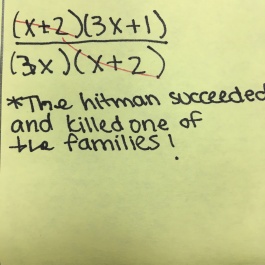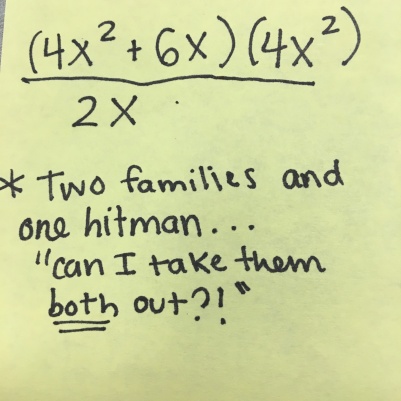Starting my second year of teaching.Thankfully, I had one prep that didn’t change, Geometry! I’m finally out of the “holding my head up right above the water so I don’t drown” year and am finally truly changing and analyzing my classes. This year I decided to have two main goals.
- I want my students to speak and debate mathematically
- I want my students to write mathematically
For this post, I’m going to focus on goal #1. In my first week back, I created more mathematical discussion than I had the entire previous year.
At Twitter Math Camp this summer, I went to a morning session with Mattie Baker and Chris Luzniak about creating a culture of mathematical discussion and debate. One of the many ways to do this was to set up a classroom environment is which students use the format
My claim is____________. My warrant is _____________ to express and justify their ideas.
I started using this format on the first day of class. I started asking fun questions like “what’s your favorite movie?” “where’s your favorite vacation spot” and some “would you rather” questions. This was a great way to help students become comfortable with the format, get comfortable with each other, and helped me learn their names very quickly. We continued with these same type of questions on day two.
Next, I started asking more mathematical questions, specifically for vocab that they were supposed to look up the night before for homework. I called on two or three students per vocab word to hear their opinions. If there was a controversial word, I asked more students for their thoughts. This was a great way to go over and discuss vocab in an interactive way. I could also see what misconceptions they had of certain words.
Then I used this to explore a topic that we hadn’t really focused on yet. For homework, I had students look up the definition of congruent and equal and compare them. When they submitted their responses I could tell that there were misconceptions. Students also didn’t know when to use equal versus congruent. I decided to start the class with some claims and warrants. The entire class became involved in the discussion on where = or congruent belongs and WHY it belongs there.
I have also used this to discuss a topic that we learned the day before. Chris had a great activity debating if the best method of finding distance is the Pythagorean theorem or the distance formula (depending on the information given). I let students work through the three distance problems but also provide a claim and warrant for why they chose that method. At the end of class, we shared our claim and warrants as a class.
I’ve really enjoyed implementing claim and warrants into my class so far. I can’t wait to try (and blog) once I try other things from this session!









 g about killing off family members of the Mafia.
g about killing off family members of the Mafia.






 t to see if they discount remained the same!
t to see if they discount remained the same!


